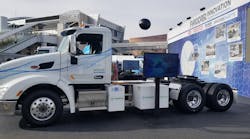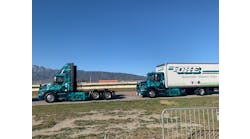Trucking seems to have found a permanent home at a place that not long ago may have appeared to be a mismatch.
Previously known as the Consumer Electronics Show, the name of the annual event was changed several years ago to CES, in part to reflect the growth of vehicle technologies that attract 170,000 attendees to Las Vegas each year.
Colin Sutherland, executive vice president of sales and marketing for Geotab, suggested the “Connected Technology Show” could be an appropriate name for the event.
Geotab was among the companies at CES focusing on “smart cities” — a vision where e-commerce, automation and electric technologies converge to create a connected and harmonious future for all.
Sutherland noted Sony Corp. pulled off one of the biggest surprises of CES by unveiling a prototype Vision-S electric vehicle. While not developed for public sale, Sutherland shared his belief that if a company like Sony can build an entire electric vehicle without any leaks to the media, it should be a “signal this isn’t as complicated” as some may believe.
The Central Plaza area of the Las Vegas Convention Center was once again the center of trucking-specific innovation. Paccar Corp., the first truckmaker to exhibit back in 2018, was once again on hand this year.
As part of its booth, Peterbilt Motors displayed an electric refuse truck, while Kenworth Trucks showed a medium-duty electric model and a Level 4 autonomous T680 tractor.
Joining the companies was Dana Holding Corp., which is working with the Paccar brands to accelerate the development of the battery-electric trucks. This was the first CES for Steve Slesinski, Dana’s director of product planning. He said it felt like a perfect venue to showcase all that goes into these “rolling computer chassis.”
Moments later, Jeff Abeson, vice president of business development at Ryder System, shared a similar feeling as CES attendees lined up at Ryder’s booth to get a closer look at the hydrogen-powered Nikola Two.
There was no mistaking the emphasis on electrification at this year’s event, from faster charging infrastructure to cheaper car models with longer battery ranges.
At the same time, CES remains an event filled with imaginative driver and vehicle safety technologies. Some come from start-ups hoping to become the next big thing, while others are presented by long-established global brands.
For example, Continental Tire displayed its “transparent hood” technology, which utilizes multiple cameras to give drivers greater visibility of the ground view around them.
“This first-of-its-kind technology has the potential to make a major impact on drivers everywhere, especially with reducing vehicle damages while parking,” Continental said.
Bridgestone Corp. made its CES debut, sharing a vision of the “not too distant world” that includes air-free tires that never go flat. Likewise, its smart tire technology will be able to communicate with future autonomous vehicles to ensure a level of safety required in potential driverless situations.
Many of the companies at CES that develop LiDAR systems and other autonomous technologies are no longer new, but they are regularly making advancements in the ability to detect obstacles in complete darkness, fog, rain, and glare. Curvy roads, potholes, and exit ramps were among the obstacles companies claimed this year their systems can now safely navigate.
Among the other items seen at CES:
• Three-way cameras able to capture every moment in 360 degrees inside and outside of the vehicle, providing a more complete picture of what led to an accident or dangerous driving incident.
• Location technology able to pinpoint a location to emergency personnel within about three feet, allowing for faster response times for first responders.
• A “traditional” windshield that can be used to stream entertainment and view trip navigation when the vehicle is shifted into autonomous mode from manual driving mode.
• Use of “emotional recognition” technology that automatically changes indoor ambiance to match a driver’s mood.
In the end, I left CES quite exhausted from the miles and miles of walking. And if the artificial intelligence technology I tested is still reading my feelings correctly, I’m intrigued what’s to come next.



